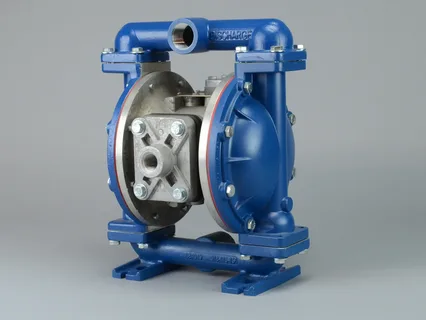Introduction
Diaphragm pumps, also known as membrane pumps, are positive displacement pumps that use a combination of reciprocating action and flexible diaphragms to move liquids. These pumps are valued for their ability to handle corrosive, viscous, and abrasive fluids, as well as their suitability for hygienic and hazardous environments. Diaphragm pumps find widespread use across industries such as water & wastewater treatment, chemicals, pharmaceuticals, food & beverages, oil & gas, and mining. Their versatility, leak-free design, and ability to run dry without damage make them increasingly attractive for modern industrial processes.
Market Dynamics (Drivers, Challenges, Opportunities)
Drivers:
The global market for diaphragm pumps is growing due to rising demand for efficient water and wastewater management, especially in urban areas facing water scarcity and industrial pollution. Increasing investments in the oil & gas sector and chemical processing industries further boost adoption. The pharmaceutical and food industries also rely on diaphragm pumps for hygienic and contamination-free fluid transfer. Additionally, strict environmental regulations are pushing industries toward leak-free pumping solutions, a major strength of diaphragm pumps.
Challenges:
One of the key restraints is the relatively high maintenance cost due to wear and tear of diaphragms, especially when handling abrasive or aggressive fluids. Pulsation and vibration during operation can also create performance inefficiencies in certain applications. Competition from alternative pump technologies, such as centrifugal pumps in high-flow applications, can limit market penetration. Moreover, the fluctuating cost of raw materials such as elastomers and metals adds pressure to manufacturers.
Opportunities:
Growing pharmaceutical production, food safety regulations, and advancements in materials science offer opportunities for diaphragm pumps with improved durability and performance. The increasing focus on renewable energy, including biofuels, creates new avenues for diaphragm pumps in chemical and process applications. Emerging economies present significant growth potential, particularly in water treatment projects and industrial expansion. Furthermore, the development of smart, automated, and energy-efficient diaphragm pumps with IoT integration opens opportunities in predictive maintenance and process optimization.
Market Segmentation
By Mechanism: Air-operated diaphragm pumps (AODD) and electrically operated diaphragm pumps (EODD). AODDs dominate due to their ability to handle solids, abrasives, and hazardous liquids, while EODDs are gaining traction for energy efficiency.
By Operation: Single-acting and double-acting diaphragm pumps. Double-acting pumps provide continuous flow and are widely used in industrial settings.
By Material: Plastic (PP, PVDF), stainless steel, cast iron, aluminum, and others, depending on the nature of fluid being pumped.
By Application: Water & wastewater, chemicals, oil & gas, pharmaceuticals, food & beverages, mining, paints & coatings, and agriculture.
By Region: North America, Europe, Asia-Pacific, Latin America, and Middle East & Africa.
Regional Analysis
Asia-Pacific is the largest and fastest-growing market, driven by industrialization, infrastructure development, and rising demand for water treatment facilities in China, India, and Southeast Asia. North America sees strong adoption in oil & gas, chemicals, and pharmaceuticals, with the U.S. leading the market. Europe emphasizes food safety, clean water, and environmental regulations, boosting diaphragm pump adoption in food, pharma, and wastewater sectors. Latin America is witnessing increasing use in mining, agriculture, and oil & gas, especially in Brazil and Mexico. Middle East & Africa markets are supported by oil & gas projects and rising investments in water infrastructure.
Key Trends
- Rising demand for water treatment: Growing concerns over water scarcity and pollution are boosting diaphragm pump demand in municipal and industrial wastewater applications.
- Preference for air-operated diaphragm pumps (AODD): Industries handling aggressive, hazardous, or solid-laden fluids are increasingly adopting AODDs.
- Material innovation: Development of advanced elastomers and corrosion-resistant materials enhances pump durability and efficiency.
- Automation and smart pumping: IoT-enabled diaphragm pumps with real-time monitoring and predictive maintenance features are gaining momentum.
- Sustainability push: Eco-friendly and energy-efficient designs are aligning with global sustainability goals.
- Growth in pharmaceuticals and food industries: Stringent hygiene requirements are driving diaphragm pump usage in sterile fluid handling applications.
Future Outlook
The diaphragm pumps market is expected to maintain strong growth due to rising demand in water treatment, chemicals, and pharmaceuticals. The increasing adoption of automation and smart monitoring technologies will create more efficient and reliable pump systems. Asia-Pacific will continue to dominate, supported by infrastructure and industrial investments, while North America and Europe will emphasize innovation, energy efficiency, and compliance with strict regulations. The market will also benefit from growing demand in emerging applications such as renewable energy, paints & coatings, and agriculture.
Conclusion
Diaphragm pumps are a critical component in fluid handling applications across industries due to their versatility, safety, and reliability. Their ability to manage corrosive, viscous, and hazardous liquids positions them as an indispensable solution in modern industries. Despite challenges like maintenance costs and competition from other pump technologies, opportunities in pharmaceuticals, food, renewable energy, and water treatment will sustain strong demand. With trends like smart pumping and eco-friendly designs, the diaphragm pumps market is poised for continued growth.

